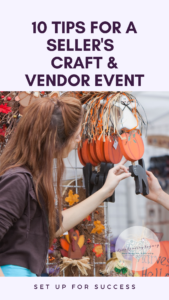Ten Tips For A Seller’s Successful Craft & Vendor Event
We may earn money or products from the companies mentioned in this post.
After several years of being a vendor at festivals, craft shows, and other vendor events, I’ve seen a lot of what makes other vendors successful sellers. Often the coordinator is to blame if selling of goods doesn’t happen. Sometimes it is due to poor advertising and promoting by the coordinator, or whether they brought in shoppers who are different than an individual seller’s ideal customer, or the location was not ideal, or even that there is too much of a certain category of products (jewelry, candles, wood signs, crocheted products, etc). To be fair, the success or failure of a seller’s experience isn’t all on the shoulders of the coordinator, however. Success also depends on the independent seller and the quality of the products that have been made or are being sold, and even how products are priced. I have been in events where the coordinator didn’t advertise, didn’t use grammar or sentence structure in advertising, didn’t draw in crowds of people, or the atmosphere was toxic, and still either sold a good bit of my merchandise, or gained a longstanding faithful customer, even if it is another vendor. After a few unsuccessful events, I’ve had to consider my own methods and whether or not they have contributed to my success or failure. A little self reflection goes a long way!
What are the ways for a seller to set themselves up for a successful craft/vendor selling event?
Here are ten things I consider important to the success of my own events.

- Sellers should set up the booth in a way that allows people to see the vendor or seller’s face, not only the products. Customers need to know who is in charge of a booth, and who to know, like and trust. Craft shows are for a more personal shopping experience! For example, I recently visited a booth that was set up so that there was a solid outer wall of delicate glass items. The rest of the booth was behind the wall. I nearly didn’t walk into the booth b/c I wasn’t sure if only the outer wall was a the booth, and the items inside was extra inventory. The vendor was set up in the far corner, closed off from the front of the booth, almost like she was hiding. I wasn’t even sure the person was the one in charge of her own booth! It was very unwelcoming and intimidating. I almost didn’t make my purchase.
- Stay off your phone, saving to post photos to social media, using it for invoicing, etc.
- Face the crowd with a smile. Engage shoppers! Compliment people “I love your shirt.” “What a cute baby.” Offer candy to shoppers, or stickers to children so their adults can shop!
- A seller should say THANK YOU! when shoppers make a purchase. “Happy Thanksgiving.”, “Have a great holiday.”, or “I hope you feel better soon.”, etc, also makes the purchase personal. A seller should show evidence of care to their shoppers.
- A seller should create an email list with shopper information so that follow up with a thank you for the purchase or sending happy snail mail can occur. A seller can also send exclusive show discounts to email list customers. Customers should be invited to be repeat customers and shoppers!
- A craft or direct selling seller should advertise where they are selling next on their own social media outlets.
- On social media advertising events, interact with other people’s posts to gain new shoppers. Interact with event posts, do not just like them.
- A seller should share their presence, products of what they have to offer, or specials into the coordinator’s social media EVENT first, then share that post to business pages and groups. Events are public but must be shared for visibility. Show coordinators’ groups are not always public, so what is seen is limited to those people in the group only. By sharing from the event to the group, social media algorithms are improved. Engagement on posts increases visibility.Shoppers are watching vendors for who to know, like, and trust. Vendors create verbal referrals this way, so interact a lot. It is part of advertising and supporting a seller’s own show and business.
- A seller should be prepared to share with their people where their booth will be! It’s not enough to say “I’m along the wall in xyz room or building.” Know the booth number, the room or building, and share that information. Some shoppers want to know where to find a seller because they have a shopping plan based on what they see in the event and in the group. Shoppers may have limited time. It’s a seller’s job, as the business, to meet the needs of the shopper. Shoppers probably won’t wander aimlessly looking for a seller, or they will forget about the seller. A seller could be losing sales because they can’t find the adorable item they saw posted.
- On a seller’s own business pages, groups, and personal timelines, they should share other crafters/vendors names/etc and refer to them! Build each other up that way. Sellers are all in the same boat as they work their businesses. Word of mouth referrals are awesome!
What are some of your top tips for the success of a seller at a craft/vendor show, festival, or event? I’d especially love to hear what shoppers think!


